We all know that spiders have eight legs and eat insects, but do you know which spiders are the biggest in Florida? With its temperate climate and plentiful insect prey, Florida is home to many species of spiders. They may not be quite as big as the bird-eating tarantula, but the biggest spiders in Florida are nothing to laugh at.
Here, we’ll learn about the seven largest spiders in Florida. We’ll cover where they live, what they look like, what they eat, and how common they are. Number one on our list just might make you cringe!
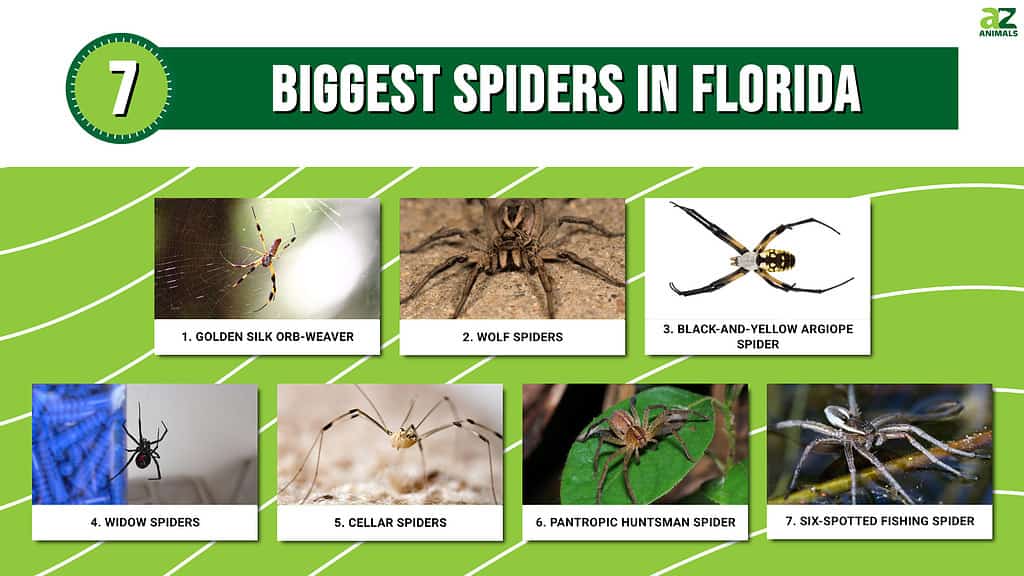
What are the Biggest Spiders in Florida?
When determining which spider is bigger, it’s important to take several factors into account. These are the spider’s body size and leg span. Depending on who you ask, any one of these numbers might be used to determine which spiders are the biggest in Florida. To help narrow things down, we’ve put all these numbers together in a table, let’s take a look.
| Spider | Body Size | Leg Span |
|---|---|---|
| Six-spotted Fishing Spider | 0.75 in | 2.5 in |
| Pantropic Huntsman Spider | 1 in | 5 in |
| Cellar Spider | 0.4 in | 2 in |
| Widow Spiders | 0.5 in | 1.5 in |
| Black-and-yellow Argiope Spider | 1.1 in | 1.5 in |
| Wolf Spider | 1 in | 4 in |
| Golden Silk Orb-Weaver Spider | 3 in | 5 in |
Now, let’s take a deep dive into the seven biggest spiders in Florida.
7. Six-Spotted Fishing Spider (Dolomedes triton)
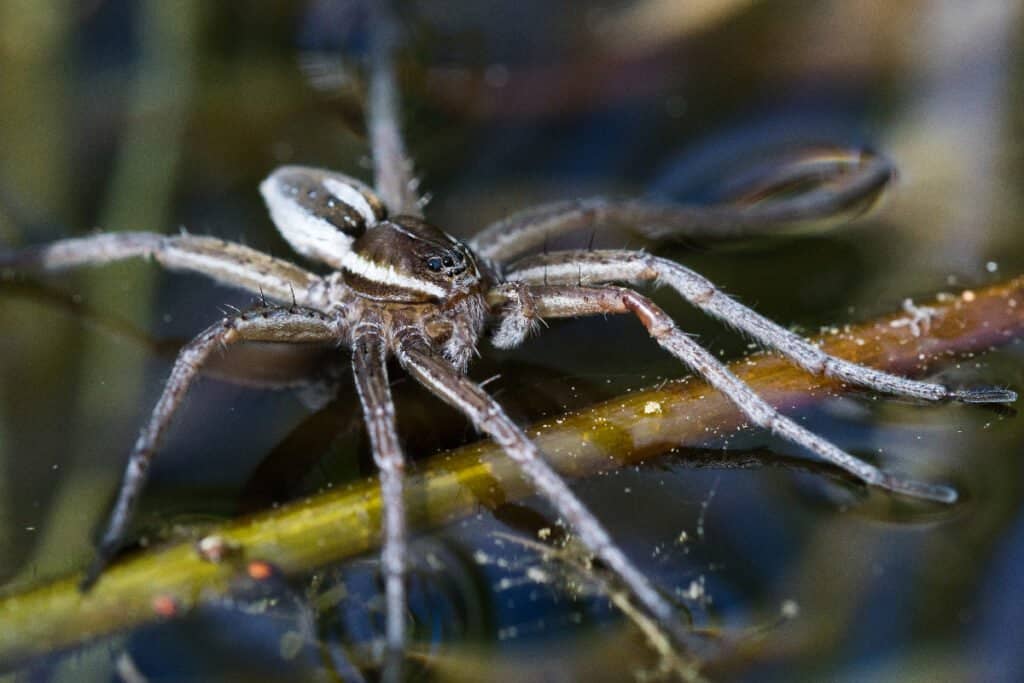
Sometimes called dock spiders, six-spotted fishing spiders spend their lives on or near the water.
©Jukka Jantunen/Shutterstock.com
Six-spotted fishing spiders have dark brown to black bodies with white or tan stripes on either side of their narrow heads and abdomens. They eat tadpoles, frogs, and small fish. Fishing spiders are some of the biggest spiders in Florida and live in almost any freshwater environment with suitable prey.
6. Pantropic Huntsman Spider (Heteropoda venatoria)
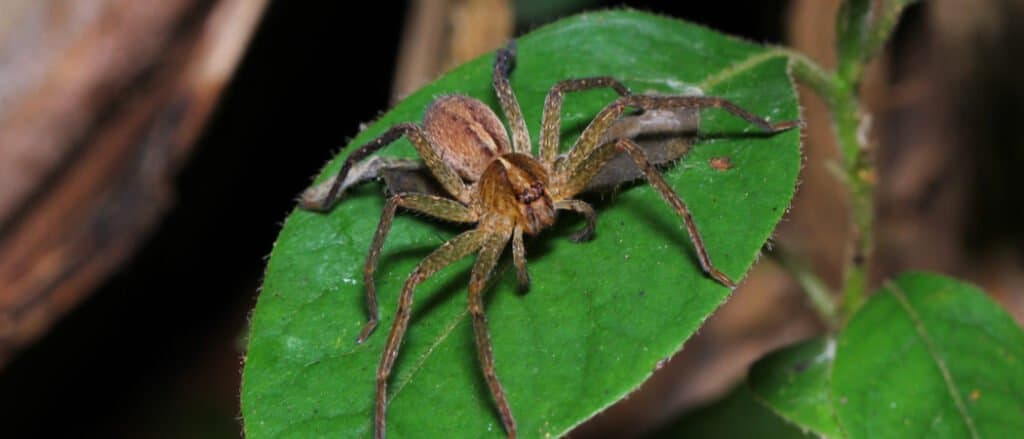
Huntsman spiders are also known as banana spiders or giant crab spiders.
©Pong Wira/Shutterstock.com
Huntsman spiders, or giant crab spiders, as they’re known in Florida, aren’t native to the United States. Scientists believe this species originated in Asia. They’re one of the biggest spiders in Florida, with adults reaching up to 5 inches in leg span. As with most spiders, females are bigger than males, though their legs are a bit shorter than those of males.
Huntsman spiders are light brown with dark brown markings. Up close, they have a furry appearance and long spikes on their legs. Females carry their egg sacs with them. Each egg sac can contain up to 200 eggs, which makes the egg sac a heavy load to carry. The huntsman spider’s primary prey are large insects, like cockroaches and crickets.
5. Cellar Spiders (Daddy Long Legs)

These spiders have very long, thin legs, and narrow bodies.
©Rob Hainer/Shutterstock.com
Cellar spiders, or daddy long legs, as they’re commonly known, live throughout the United States. The long legs that give them their name make them one of the biggest spiders in Florida. Cellar spiders’ bodies grow up to 0.4 inches long, with legs reaching up to 2 inches across. Daddy long legs eat small insects, like flies and ants. They can be found in most urban settings; they’re completely harmless to humans.
4. Widow Spiders (Including Southern, Northern, Brown, and Black)

This genus also includes brown widows, southern widows, and northern widows.
©Ken Thomas / public domain – License
Number four on our list of the biggest spiders in Florida is the widow spider. Black widows are famously known for their red hourglass markings, and for their potent venom. Females of this genus grow to about twice the size of males. Adult widow spider’s bodies can reach half an inch in length, with legs up to 1.5 inches across.
Widow spiders weave webs, which they use to catch flying prey like flies, mosquitos, and crickets. Once trapped, widow spiders bite and envenomate their prey. Luckily, bites on humans are uncommon, and almost never life-threatening.
3. Black-and-yellow Argiope Spider (Argiope aurantia)

These spiders are also known as corn spiders, zipper spiders, writing spiders, or golden garden spiders.
©iStock.com/DianaLynne
One of the most striking of the biggest spiders in Florida, the black-and-yellow argiope frequents gardens and landscaped areas. These web weavers have brilliantly colored thoraxes marked by alternating yellow and brown markings. Their legs are orange and black, and their heads tend to be gray. Males are much smaller than females, which grow up to 1.1 inches long in the body, with legs up to 1.5 inches long. Black-and-yellow argiope spiders are garden favorites due to their ability to cull insect populations.
2. Wolf Spiders
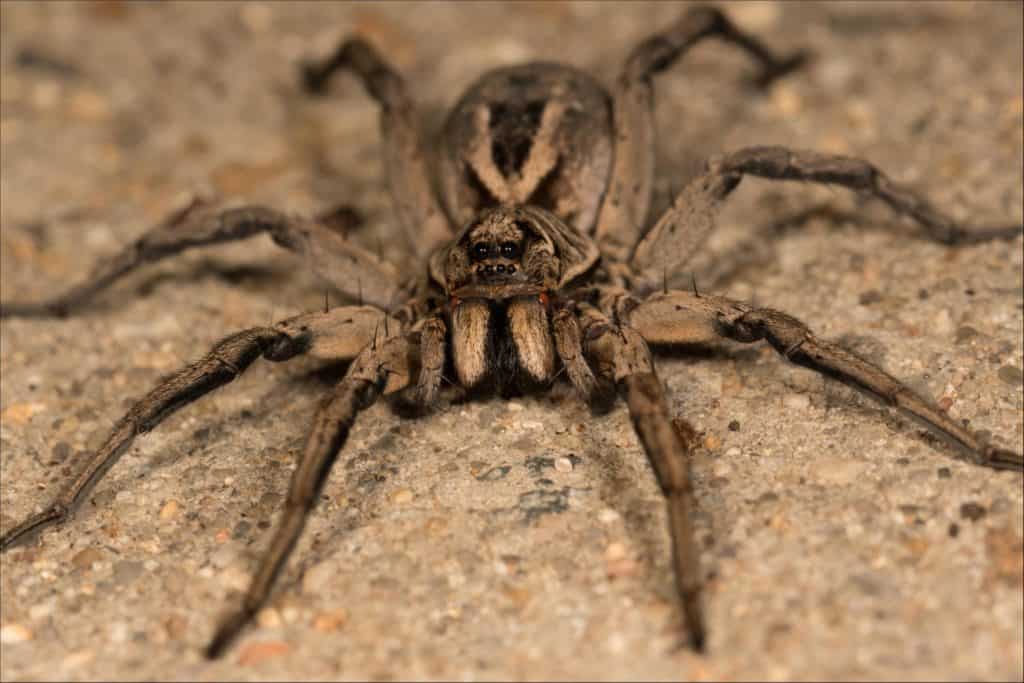
Common all over the world, there are nearly 3,000 separate species of wolf spiders.
©Katarina Christenson/Shutterstock.com
Wolf spiders may be one of the most famous spiders in the world. They live everywhere, and females are known for carrying their young (spiderlings) on their backs. These spiders don’t build webs, like number one on our list of the biggest spiders in Florida. Instead, they hunt by ambush, waiting for insects to pass by.
Wolf spiders grow up to one inch long, with up to two-inch long legs. To go along with their size, they’re thick-bodied spiders that resemble tarantulas.
1. Golden Silk Orb-Weaver (Trichonephila clavipes)
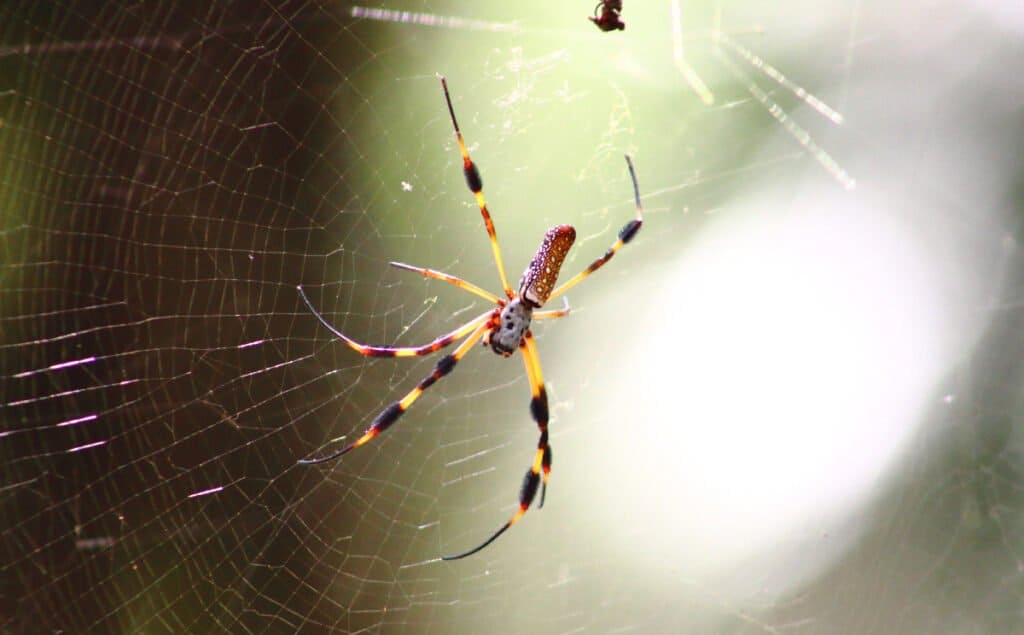
These gorgeous spiders are also known simply as golden silk spiders.
©Max Rossa/Shutterstock.com
The title of biggest spider in Florida goes to the incomparable golden silk orb-weaver. These spiders have long bodies with even longer legs characterized by alternating brown, black, and yellow bands. Their bodies are yellow and can grow up to three inches long. But, that’s not the biggest thing about them—golden silk spiders have legs that can reach up to 5 inches across.
These incredible spiders prey mostly on flying insects, like flies, wasps, and bees. Females are much larger than males. In fact, female golden silk orb weavers are the largest orb weavers in the United States. Golden orb-weavers are common in the southern United States, where they frequently build their webs across hiking trails, much to the consternation of hikers and backpackers.
Summary Of The 7 Biggest Spiders In Florida
| Rank | Spider | Size, including Legs |
|---|---|---|
| 7 | Six-Spotted Fishing Spider (Dolomedes triton) | Grow up to 0.75 inches and have up to 2.5 inches in leg span |
| 6 | Pantropic Huntsman Spider (Heteropoda venatoria) | Adults have a body size of 1 inch, reaching up to 5 inches in leg span |
| 5 | Cellar Spiders (Daddy Long Legs) | Bodies grow up to 0.4 inches long with legs reaching up to 2 inches |
| 4 | Widow Spiders (Including Southern, Northern, Brown, and Black) | Adult bodies can reach 0.5 inches in length with legs up to 1.5 inches |
| 3 | Black-and-yellow Argiope Spider (Argiope aurantia) | The larger females grow up to 1.1 inches long with legs up to 1.5 inches |
| 2 | Wolf Spiders | Grow up to 1 inch long with up to 2-inch long legs |
| 1 | Golden Silk Orb-Weaver (Trichonephila clavipes) | Grow up to 3 inches long and have legs that can reach up to 5 inches |
Bonus: What Keeps Spiders Away

Essential oil scents like lavender are repugnant to spiders.
©botamochi/iStock via Getty Images
One of a person’s worst nightmares is having spiders wind up in their home–especially the poisonous kind! The best way to avoid getting bitten by a spider is to try and prevent them from entering your house in the first place. As spiders can get into your home through holes and cracks, you can check for possible entryways with a flashlight. If the light gets through from the inside to the outside, you should fill that hole or crevice with an appropriate product.
Keeping your yard free of debris and overgrown vegetation helps cut down on areas spiders would gravitate to. Caulking doors and windows is also a good strategy to keep them out.
Spiders hate certain scents, so scented essential oils can help deter them like peppermint, tea-tree, lavender, and rose. You can add 15-20 drops of a particular oil in a water bottle mixed with water and spritz it around your house. They also hate the smell of cinnamon and vinegar, so these scents can be used similarly.
Rubbing lemon or orange peels on the baseboards along your walls, on window sills, and on other surfaces can also repel spiders, who dislike citrus smells. Furniture polish and cleaning products with lemon scent can also help.
Regular cleaning inside your home, especially in areas that are dark or less frequented, is necessary to keep spiders from setting up residence. It’s also important to keep an eye on fruit bowls, as they can attract spiders.
Honorable Mention: Other Large Spiders in Florida

The green lynx spider (
Peucetia viridans) is much larger than average spiders in the Oxyopidae family
©Judy Gallagher, CC BY 2.0 – License
Florida is home to more than 250 species of spiders that can be found in all shapes and sizes, from the rather large golden silk orb-weaver mentioned earlier to the tiny jumping spider. It may come as some comfort to those of you suffering from arachnophobia to know that not all 250 are quite as large as the ones on this list, although there are still a few that may come close and deserve an honorable mention. Here are a few additional spiders that rank closer on the size of large:
- Woodlouse Spider (Dysdera crocata) – this spider is known by a variety of names, from the woodlouse hunter, pillbug hunter, and sowbug killer, although its primary targeted prey is the woodlouse. Adults generally range in size but the females are the larger of the species, with typical body sizes of between 0.43 to 0.59 inches (males range between 0.35 to 0.39 inches)
- Long-jawed Orb Weaver (Tetragnathidae) these fairly large spiders belong to the family of araneomorph spiders that have elongated bodies and legs. Their bodies may not be exceptionally large, only about half an inch, but their legs can stretch up to two inches long. Like with many other spider species, the females tend to be larger than the males.
- Green Lynx Spiders (Peucetia viridans)- this spider is much larger than average spiders in the Oxyopidae family, with females having the potential to reach body lengths of one inch (26 millimeters), with legspans of up to 2.75 inches (70 millimeters). Although the average body length is closer to between half an inch to 0.62 inches. Male green lynx spiders are slightly smaller.
The photo featured at the top of this post is © Paul Looyen/Shutterstock.com
Thank you for reading! Have some feedback for us? Contact the AZ Animals editorial team.







